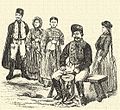| This article includes a list of references, related reading, or external links, but its sources remain unclear because it lacks inline citations. Please help improve this article by introducing more precise citations. (November 2014) (Learn how and when to remove this message) |
| Csíkszék | |
|---|---|
| Seat of the Székely Land | |
| 11th century–1876 | |
| Capital | Csíksomlyó |
| Population | |
| • 1867 | 111,237 |
| History | |
| • Settlement of the Székelys | 11th century |
| • Administrative reform of the Kingdom of Hungary | 1876 |
| Today part of | Romania |
| Șumuleu Ciuc is the current name of the capital. | |
Csíkszék (Hungarian pronunciation: [ˈt͡ʃiːkseːk]) was one of the Székely seats in the historical Székely Land.
It administered two sub-seats (Hungarian: fiúszék, Latin: sedes filialis), namely Gyergyószék and Kászonszék. It was divided on the natural borders of the region, as the main territory of Csíkszék lay in the valley of the Olt River, Gyergyószék lay in the valley of the river Maros (Mureș), while Kászonszék lay in the valley of the river Kászon (Cașin).
Population
The religious composition of Csíkszék's population in 1867 was as follows:
- Roman Catholic: 96,525
- Greek Catholic: 13,028
- Eastern Orthodox: 17
- Others: 1.667
- Total: 111,237
Gallery
-
 The Franciscan Church and Monastery in Csíksomlyó
The Franciscan Church and Monastery in Csíksomlyó
-
 The Guildhall of Csíkszék in Csíksomlyó
The Guildhall of Csíkszék in Csíksomlyó
-
 The castle of Csíkszereda
The castle of Csíkszereda
-
 People of Csíkszék in traditional costumes
People of Csíkszék in traditional costumes
References
- Orbán, Balázs (1868). A Székelyföld leírása. Pest: Panda és Frohna Könyvnyomdája.
This Hungarian history article is a stub. You can help Misplaced Pages by expanding it. |